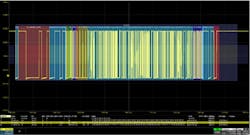Oscilloscope software for automotive control and network test and measurement introduced by Teledyne LeCroy
CHESTNUT RIDGE, N.Y. – Teledyne LeCroy in Chestnut Ridge, N.Y., is introducing a CAN XL trigger, decode, measure/graph, and eye diagram (TDME) oscilloscope software option to enable users to test, validate, and debug automotive electronic control units (ECUs) and 10-megabit-per-second in-vehicle network (IVN) designs.
The software option is for today’s vehicles, which can contain more than 100 ECUs connected by an IVN that uses serial data signals to transmit information. Many factors are increasing the demand for more data capacity in the IVN: data from radar, lidar, cameras, and other sensors used for autonomous driving technologies.
The trend towards vehicle electrification, which uses the network to operate distributed systems; and the emergence of connected vehicle technologies to improve safety, system efficiency, and mobility.
In response, vehicle manufacturers are adapting existing, domain-based IVN architectures to operate at higher speeds. For instance, Controller Area Network (CAN) at 500 kilobits per second and CAN Flexible Data-rate (CAN FD) at 2 megabits per second have been updated to operate at 10 megabits per second, the CAN XL specified rate.
Longer term, the new zonal IVN architectures, primarily using 10Base-T1S, will improve cost and reliability of IVNs. Test and measurement support for CAN XL and 10Base-T1S standards in oscilloscopes will be critical to automakers as they implement CAN XL in existing vehicles while designing newer and premium vehicles that use 10Base-T1S.
For more information contact Teledyne LeCroy online at https://teledynelecroy.com.
